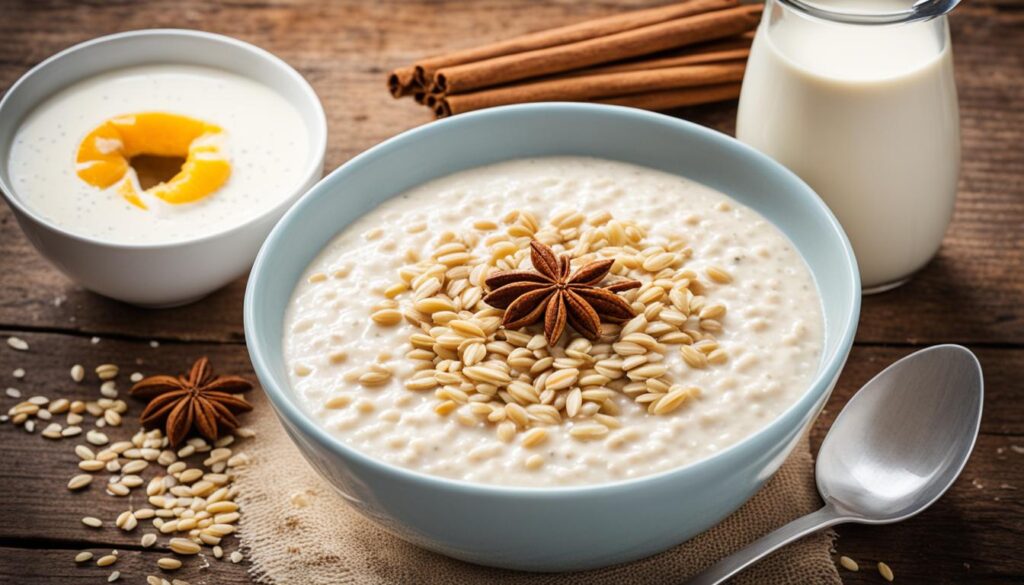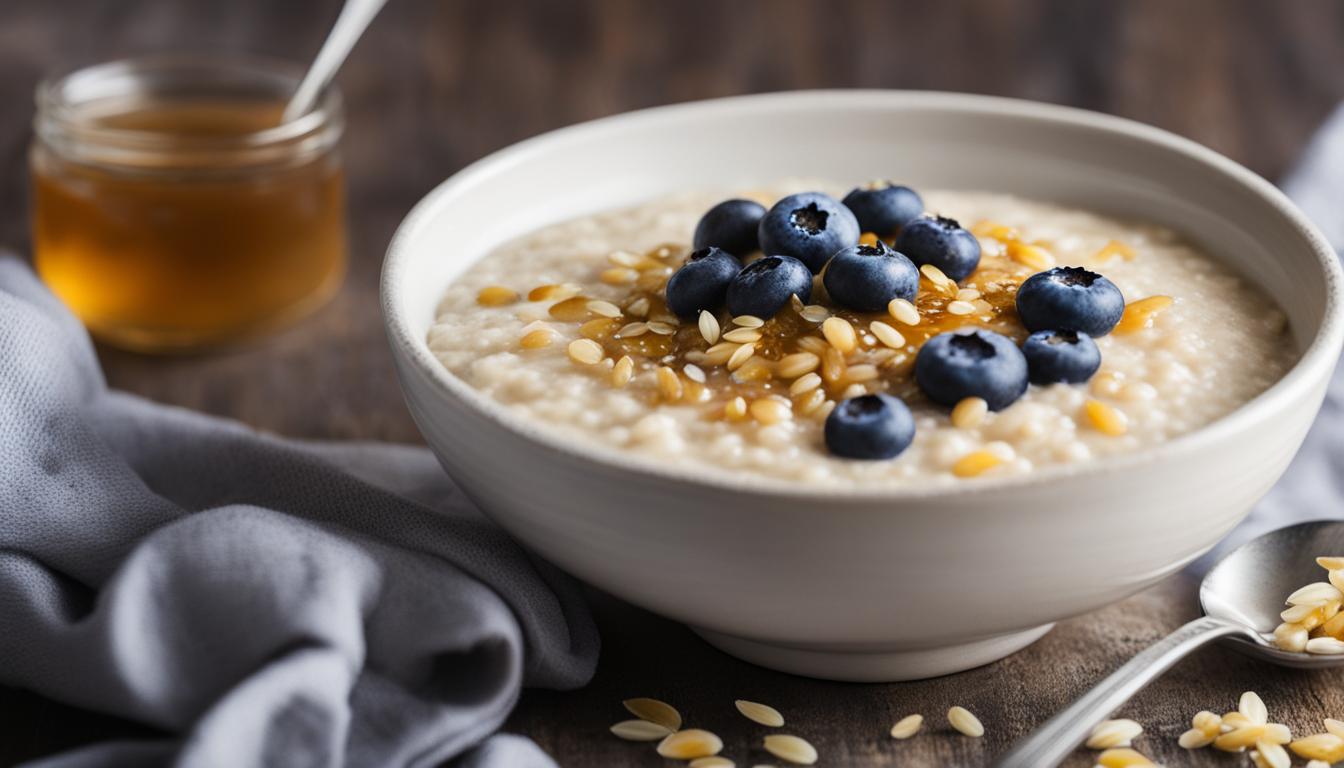Have you ever wondered how to make a delicious and nutritious breakfast that will keep you satisfied until lunchtime? If so, we have the perfect recipe for you: Creamy Milk Barley Porridge! This quick and easy recipe combines the goodness of barley with the creaminess of milk to create a breakfast option that is both comforting and nourishing.
Barley is a versatile ancient grain that is packed with fiber and nutrients, making it an excellent choice to start your day. But what sets this barley porridge apart? How does it achieve that perfect creamy texture? And what are the customization options available for you to make it truly your own?
Key Takeaways:
- Creamy Milk Barley Porridge is a quick and easy breakfast option.
- Barley is a high-fiber ancient grain that provides numerous health benefits.
- The combination of milk and barley creates a creamy and satisfying texture.
- Barley porridge can be customized with various toppings and flavors.
- This recipe offers a warm and comforting start to your day.
Why Choose Barley Porridge for Breakfast?
Barley porridge is a great choice for breakfast for several reasons. Firstly, it is creamy and satisfying, providing you with a hearty start to your day. Additionally, barley is a healthy grain that is high in fiber, which can help keep you full and satisfied until your next meal. The combination of milk and barley creates a delicious flavor and creamy texture. Lastly, barley porridge can be easily customized with toppings and flavors to suit your taste preferences.
With its creamy texture and delicious flavor, barley porridge is a breakfast option that will leave you feeling satisfied and energized. Whether you’re looking for a warm and comforting start to your day or a nutritious meal that will keep you full until lunchtime, barley porridge is a perfect choice.
“Barley porridge is a wholesome and satisfying breakfast option. It provides a good balance of carbohydrates, protein, and fiber to fuel your morning and keep you feeling fuller for longer.”
The Benefits of Creamy Barley Porridge
There are several reasons why you should consider adding creamy barley porridge to your breakfast routine:
- Rich in Fiber: Barley is high in fiber, which aids digestion and helps maintain a healthy digestive system.
- Nutritious and Filling: Barley is a nutrient-dense grain that provides essential vitamins, minerals, and antioxidants. It also helps keep you full and satisfied, reducing the urge to snack throughout the morning.
- Customizable: You can easily personalize your barley porridge with various toppings, such as fresh fruits, nuts, seeds, or a drizzle of honey, to suit your taste and add extra nutritional value.
- Versatile: Barley porridge can be enjoyed on its own or paired with other breakfast items, such as yogurt, fresh berries, or a sprinkle of cinnamon, for a delicious and diverse morning meal.
By choosing creamy barley porridge as your breakfast option, you can enjoy a delicious, nutritious, and customizable meal that will keep you fueled and satisfied throughout the day.
How to Make Creamy Barley Porridge with Milk
Making creamy barley porridge with milk is a simple and easy process that results in a delicious and satisfying breakfast. Follow these steps to prepare a bowl of warm and comforting barley porridge:
- In a saucepan, combine milk and water in equal parts and bring it to a boil.
- Add the barley to the boiling mixture and reduce the heat to a simmer.
- Cook the barley for 40-45 minutes, stirring occasionally to prevent sticking.
- Once the barley is cooked and tender, remove the saucepan from heat.
- To enhance the flavor, add maple syrup, a splash of vanilla extract, and a pinch of ground cinnamon to the porridge. Stir well to incorporate.
- If desired, adjust the consistency of the porridge by adding more milk. This step allows you to customize the thickness of your barley porridge according to your preference.
- Serve the creamy barley porridge warm in a bowl.
- Add your favorite toppings such as fresh fruits, nuts, seeds, or a drizzle of honey to enhance the taste and texture.
Enjoy your homemade barley porridge for a wholesome and nutritious breakfast!
Tips:
- Soak hulled barley overnight before cooking to reduce the cooking time.
- Cook the barley porridge on low heat to prevent burning.
- If the porridge becomes too thick, you can add more milk to adjust the consistency.
- Experiment with different flavors such as adding mashed bananas or blueberries to the porridge for a fruity twist.
- Try savory toppings like avocado, feta cheese, or poached eggs for a savory version of barley porridge.
Tips and Variations for Barley Porridge
Here are some tips and variations for making barley porridge.
1. Soak Hulled Barley Overnight
If using hulled barley, it is recommended to soak it overnight before cooking to reduce the cooking time. This step softens the grains and allows for faster and more even cooking.
2. Cook on Low Heat
Cooking the barley porridge on low heat can prevent burning and ensure that the grains are cooked through without becoming mushy. This slow and gentle cooking method helps to enhance the creamy texture of the porridge.
3. Adjust Consistency with More Milk
If the barley porridge becomes too thick during cooking, you can adjust the consistency by adding more milk. This will help to achieve the desired creamy texture and ensure that the porridge is not too dry.
4. Experiment with Different Flavors
Barley porridge is a versatile dish that can be customized with different flavors. Try adding ingredients like mashed banana, blueberries, or peanut butter to create unique variations. For a savory twist, you can mix in cooked vegetables or spices like turmeric and cumin.
5. Enhance with Toppings
Add extra flavor and texture to your barley porridge by topping it with a variety of ingredients. Choose from a selection of fresh or dried fruits, nut butter, nuts and seeds, yogurt, sweeteners like honey or maple syrup, and even a sprinkle of chocolate for a touch of indulgence.

Common Toppings for Barley Porridge
| Topping | Description |
|---|---|
| Fresh fruits | Slices of banana, berries, or diced apple |
| Nut butter | Almond butter, peanut butter, or cashew butter |
| Nuts and seeds | Chopped almonds, walnuts, pumpkin seeds, or chia seeds |
| Yogurt | Plain Greek yogurt or flavored yogurt |
| Sweeteners | Honey, maple syrup, or agave nectar |
| Chocolate | Dark chocolate shavings or cocoa powder |
With these tips and variations, you can make delightful homemade barley porridge with a traditional recipe. Get creative with flavors and toppings to customize your perfect bowl of barley porridge.
Storing and Reheating Barley Porridge
When it comes to enjoying leftover barley porridge, proper storage is key to maintaining its freshness and taste. By following a few simple steps, you can store your barley porridge for future enjoyment.
Storing Barley Porridge:
Leftover barley porridge can be stored in the refrigerator for up to a week. To ensure maximum freshness:
- Transfer the porridge to an airtight container to prevent moisture and odors from affecting its taste.
- Label the container with the date and contents to easily identify it in your fridge.
- Place the container in the refrigerator, keeping it away from strong-smelling foods to avoid any cross-contamination of flavors.
Freezing Barley Porridge:
If you’d like to extend the shelf life of your barley porridge, freezing is a convenient option. Here’s how to freeze your porridge:
- Allow the barley porridge to cool completely before freezing.
- Divide the porridge into individual portions, using freezer-safe containers or resealable bags.
- Label the containers or bags with the date and contents.
- Place the containers or bags in the freezer, ensuring they are tightly sealed to prevent freezer burn.
Reheating Barley Porridge:
When it’s time to enjoy your stored or frozen barley porridge, follow these steps for successful reheating:
- Remove the porridge from the refrigerator or freezer and transfer it to a microwave-safe bowl or a saucepan, depending on your preferred method of reheating.
- Add a splash of milk or water to thin out the porridge, as it may have thickened during storage.
- For microwave reheating, heat on medium power in 30-second intervals, stirring in between, until the desired temperature is reached.
- If reheating on the stovetop, warm the porridge over low heat, stirring frequently, until it is heated thoroughly.
- Once reheated, give the porridge a good mix to ensure it is well combined.
Now that you know how to properly store and reheat barley porridge, you can enjoy this delicious and nutritious breakfast option even on busy mornings. Whether you store it in the refrigerator or freezer, your leftover barley porridge will be ready to enjoy whenever you crave a warm and comforting meal.
Soaking Barley and Gluten-Free Considerations
When it comes to cooking barley, the need for soaking depends on the variety you choose. For quick-cooking pearl barley, soaking is unnecessary and can be skipped. However, if you opt for hulled barley, soaking it overnight can help reduce the cooking time and soften the grains.
But what about gluten? It’s important to note that barley contains gluten, making it unsuitable for individuals with celiac disease or gluten sensitivity. Barley is a cereal grain closely related to wheat, oats, rye, and millet, all of which contain gluten.
If you have gluten intolerances or follow a gluten-free diet, there are alternative grains available that you can use for your breakfast porridge. Some gluten-free options include:
- Rice
- Quinoa
- Amaranth
- Buckwheat
These grains can be cooked and prepared similarly to barley, providing a hearty and nutritious breakfast alternative.
Giving a Gluten-Free Twist to Your Barley Porridge
If you’re determined to enjoy the flavors and textures of barley porridge but need to avoid gluten, you can experiment with gluten-free grains. Here’s a simple recipe modification to make your barley porridge gluten-free:
Gluten-Free Barley Porridge Recipe:
- Replace barley with 1 cup of gluten-free grain of your choice (e.g., rice or quinoa).
- Follow the same cooking instructions as for barley porridge.
- Enjoy your gluten-free alternative!
By making this simple substitution, you can still enjoy a delicious and comforting bowl of porridge without compromising your dietary needs.

Comparison of Gluten-Free Grains
| Grain | Taste | Texture | Cooking Time |
|---|---|---|---|
| Rice | Mild and neutral | Tender and fluffy | 20-30 minutes |
| Quinoa | Light nutty flavor | Tender with a slight crunch | 15-20 minutes |
| Amaranth | Earthy and nutty | Smooth and creamy | 20-25 minutes |
| Buckwheat | Rich and nutty | Soft and slightly chewy | 15-20 minutes |
These gluten-free grains offer their unique flavors and textures to diversify your breakfast options while keeping your porridge comforting and nutritious.
Health Benefits of Barley Porridge
Barley porridge offers numerous health benefits that can contribute to a nutritious and balanced breakfast. Its high fiber content and nutrient profile make it a valuable addition to your diet. Let’s explore the specific health benefits of barley porridge:
Eases Digestion
The high fiber content in barley porridge promotes healthy digestion. Fiber adds bulk to the stool, preventing constipation and promoting regular bowel movements. It also supports the growth of beneficial gut bacteria, which aids in maintaining a healthy digestive system.
Boosts Satiety
Barley porridge helps promote feelings of fullness and satiety. The fiber and complex carbohydrates in barley are digested slowly, allowing for a gradual release of energy and prolonged satisfaction. This can be particularly helpful in managing weight and preventing overeating throughout the day.
Regulates Blood Sugar Levels
The soluble fiber in barley porridge forms a gel-like substance in the digestive system. This gel helps slow down the absorption of carbohydrates, resulting in a more gradual rise in blood sugar levels. As a result, barley porridge can be a beneficial option for individuals with diabetes or those looking to maintain stable blood sugar levels.
Rich in Nutrients
Barley is packed with essential vitamins, minerals, and antioxidants. It is a good source of vitamin B-complex, including niacin, thiamin, and riboflavin. Barley also provides minerals such as iron, magnesium, phosphorus, and selenium. These nutrients contribute to overall health and well-being, supporting various bodily functions.
| Nutrient | Amount per 100g |
|---|---|
| Fiber | 17g |
| Protein | 12g |
| Vitamin B3 (Niacin) | 6.4mg |
| Vitamin B1 (Thiamin) | 0.5mg |
| Vitamin B2 (Riboflavin) | 0.2mg |
| Iron | 2.5mg |
| Magnesium | 133mg |
| Phosphorus | 264mg |
| Selenium | 36.6mcg |
Including barley porridge in your breakfast routine can provide you with a wide range of health benefits. It is a versatile and delicious option that can be customized with various toppings and flavors to suit your preferences.
Next, we’ll explore some tips and variations for making the most out of your barley porridge.
Conclusion
Creamy milk barley porridge is a delightful and nourishing traditional breakfast option that can be easily prepared and personalized to your liking. This recipe provides a satisfying and filling way to kickstart your day while reaping the benefits of the fiber and nutrients found in barley. By following the straightforward instructions and getting creative with various flavors and toppings, you can enjoy a comforting bowl of warm barley porridge that will fuel your body and invigorate your taste buds. Give it a try and experience the pure bliss of creamy milk barley porridge!
